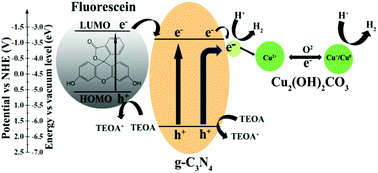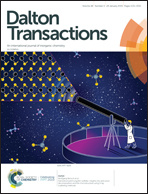Boosting the photocatalytic hydrogen evolution activity of g-C3N4 nanosheets by Cu2(OH)2CO3-modification and dye-sensitization†
Abstract
Considering the cleanness and renewability of the solar H2-production system, photocatalytic H2-production from water splitting with the assistance of nonprecious and Earth-abundant cocatalysts has become a research hotspot. Herein, robust Cu2(OH)2CO3 nanoparticles were successfully anchored onto the surface of g-C3N4 nanosheets through a mild precipitation route in which Cu2(OH)2CO3 serves as an effectively nonprecious metal-based cocatalyst for boosting hydrogen generation. The results demonstrated that the as-prepared hybrid Cu2(OH)2CO3/g-C3N4 nanocomposite photocatalyst with an optimum 3 wt% loading amount of Cu2(OH)2CO3 exhibited a noticeable improvement of photocatalytic H2-evolution performance under visible light illumination. The boosted H2-evolution activity was associated with the formation of active Cu species during the photocatalytic process, which could promote the interfacial charge separation and simultaneously reduce the overpotential of hydrogen generation, thus boosting the H2-evolution activity over the hybrid photocatalyst. More importantly, by introducing an optimum amount of fluorescein dye molecules into the photocatalytic system, the maximum photocatalytic H2-production rate over the binary Cu2(OH)2CO3/g-C3N4 photocatalyst could be further improved to be 22.6 μmol h−1, 19.3 and 3.8 times higher than those of pristine g-C3N4 and the corresponding binary catalyst without the assistance of fluorescein. These results could be ascribed to the positively cooperative effects of Cu2(OH)2CO3, fluorescein dye molecules and g-C3N4, which lead to the increasing light absorption ability, fast charge mobility and efficient charge separation of the fluorescein-sensitized Cu2(OH)2CO3/g-C3N4 hybrid photocatalyst, thus ultimately boosting the photocatalytic H2-production activity. This study may pave a new way for engineering a low-cost, high-efficiency, noble-metal-free and dye-sensitized cocatalyst/semiconductor system for solar-to-fuel conversion.



 Please wait while we load your content...
Please wait while we load your content...